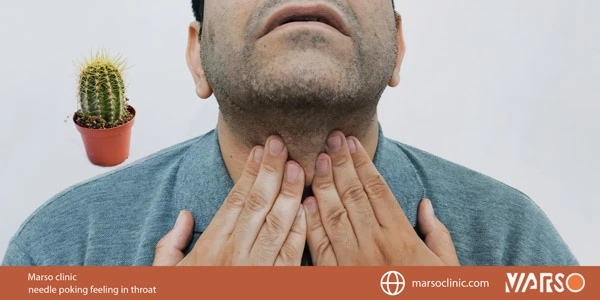Needle poking feeling in the throat may happen because of the following reasons:
- Glossopharyngeal neuralgia
- Allergies
- Stomach acid return or GERD
- Pharyngitis
- Otitis media
- Cervical discopathy
- Cervical muscle spasms
- Thyroiditis
- Pharynx disorders
- Vocal cord tumors
- Lymphadenopathy
It is considering that many other factors may cause needle feeling in the throat, but they are rare.
In the following, you will get some medical clues to find out the most probable cause for your problem and tips to get rid of it.
What you will read next:
-
- General considerations
- Glossopharyngeal neuralgia
- What is Glossopharyngeal neuralgia?
- Epidemiology
- What causes glossopharyngeal neuralgia?
- Diagnosis
- Treatment
- Allergies
- Stomach acid return or GERD
- Pharyngitis
- Otitis media
- Cervical discopathy
- Cervical muscle spasms
- Thyroiditis
- Pharynx disorders
- Vocal cord tumors
- Lymphadenopathy
- Take away
General considerations
Feeling discomfort and needle poking pain in the throat is a common complaint that one will have in many different circumstances. Among the other causes that can provoke this sensation, some are very common, like uncomplicated pharyngitis, and some are rare, like cervical masses and glossopharyngeal neuralgia.
Later in this caption, we will describe some of these causes that you may not find enough about elsewhere.
Glossopharyngeal neuralgia
- What is Glossopharyngeal neuralgia?
If you are suffering from a needle poking in the throat area and want to know the cause of this annoying feeling in the throat, you are in the right place.
>In the following, we will discuss the pain attacks in the throat caused by a condition called Glossopharyngeal neuralgia.
This disorder can cause annoying pain and needle poking in the throat.
Glossopharyngeal neuralgia is a rare disorder in the function of the ninth pair of nerves in the brain, the lingual-pharyngeal nerve or the glossopharyngeal nerve.
We have 12 pairs of nerves that emerge from the brain, each with its unique function. The ninth pair is responsible for sensation and muscle movements near the throat.
The tenth pair, the Vagus nerve, is responsible for many functions, including heartbeat, beateartbeatbeat regulation, and digestive system movements.
The pain in glossopharyngeal neuralgia has the following characteristics:
- It begins suddenly and resolves spontaneously
- Sometimes provoked by chewing, talking, or eating
- May be associated with heartbeat problems
- There is no pain between attacks
- The pain is needle-like and has sharp shooting characteristics
If you don’t experience any of the criteria mentioned above with your feeling in your throat, glossopharyngeal neuralgia may not be a good reason for your problem.
There is nothing to worry about in this disorder, and almost always, it resolves entirely and spontaneously without any long-lasting adverse effects except the consideration must be made about accompanying heart problems.
Because the pharyngeal and Vagus nerve is anatomically close to each other, in rare cases, Vagus nerves are anatomically close to each other, in rare cases, the development of glossopharyngeal neuralgia can simultaneously stimulate the Vagus nerve.
If this nerve is stimulated, it is associated with a decrease in heart rate.
Therefore, if stimulation co-occurs in the pharyngeal and Vagus nerves, the person may experience a sharp drop in heart rate and even heart failure in addition to the annoying sore throat.
Attacking pain in the throat is a rare disorder, and in this disorder, like other types of neuralgia, there will be sharp and sharp shooting attacks for only a few seconds.
A person with glossopharyngeal neuralgia will not feel pain between the attacks of the throat.
The pain of this neuralgia starts around the ear; after the pain starts, it spreads to the end of the tongue, the surrounding tonsils, the lower jaw, and even the neck.
- Epidemiology
The prevalence of this disorder is estimated to be approximately 0.7 per 100,000 adult populations worldwide.
People over 50 are at a higher risk of developing the disorder.
- What causes glossopharyngeal neuralgia?
Scientists believe that most cases of this neuralgia occur for no reason.
In some cases, it can occur secondarily to other circumstances like one with head and neck masses, a history of neck surgery, or radiotherapy.
The following are susceptible to developing glossopharyngeal neuralgia:
- Previous neck surgery
- History of radiotherapy
- Multiple sclerosis or MS
- Tumor in the brain
- Tumors in the pharynx
- Epilepsy
- Disorder in the cervical spine
Although it is rare for a mass to be the cause of this disorder, if one has sharp and shooting pain attacks in the throat, especially if there is a vague, mild, low-intensity pain between episodes, then it would be necessary to evaluate carefully for any mass and tumor in brain and neck area.
Glossopharyngeal neuralgia presents with unilateral pain in the base and back of the tongue, ear canal, and pharynx. The pain can be excruciating and continuous.
Some say that they have this pain many times during the day.
If you experience any of the following, further evaluation should be done to find out the exact cause of this problem:
- If the symptoms are bilateral, i.e., the person has a burning pain in both sides of the throat
- Experience any sickness besides needle poking feeling in the throat
- If the symptoms don’t resolve entirely and spontaneously.
- Diagnosis
The evaluation process to determine the exact cause of this disorder begins with complete history taking and full examination, especially brain and neck areas.
In addition to the history and examination, you may be asked about any disease in your family and the list of drugs you use.
Further evaluation may be performed with the direct pharyngeal examination, esophageal endoscopy, laryngoscopy, or direct laryngeal observation and nasal endoscopy.
As mentioned above, because one of the causes of pain, especially bilateral pain and burning in the throat, can be tumors of the back of the nose and throat, these tests are necessary:
Sometimes slight vascular pressure on the pharyngeal, and the lingual nerve is seen on MRI images as the cause of this disorder.
- Treatment
Treatment of glossopharyngeal neuralgia is based on medical and interventional therapy.
- Medication:
The common medications used to treat glossopharyngeal neuralgia are as follows:
Carbamazepine:
The first line of medical treatment is a medication called carbamazepine.
If you respond quickly to carbamazepine treatment, this prompt response may indicate that your doctor has made a correct diagnosis. Glossopharyngeal neuralgia responds rapidly to carbamazepine.
Treatment with carbamazepine is usually started at a dose of 200 mg at bedtime and gradually increased by another 200 mg every two days. If the pain improves or the drug reaches the maximum allowable daily dose of one thousand two hundred milligrams, severe side effects occur.
The critical point in treating a person with carbamazepine is that the person needs to be re-evaluated with a blood test and a blood cell count.
If an abnormality in the complete blood cell count happens or skin lesions produces, the drug should be discontinued immediately.
Gabapentin:
In cases where carbamazepine cannot be used, another medication is used that is called gabapentin.
The proper dosage of gabapentin to treat glossopharyngeal neuralgia is 300 mg at bedtime.
It starts with the initial dose of 300 mg at bedtime; every two days, 300 mg is added to the previous amount.
vThis process continues until the drug reaches the maximum allowable daily dose of 1,800 mg or severe side effects occur.
When the pain improves, the drug will be maintained and continued with the previous dose; for example, if a person’s pain improves with nine hundred mg daily, the drug will continue with the same amount.
Baclofen:
If the pain does not respond to carbamazepine and gabapentin or using these drugs is unsuitable, the third alternative is baclofen.
Treatment is started at the initial dose of 10 mg at bedtime.
Ten mg is added to the previous dose every five days until it reaches a maximum of 80 mg in twenty-four days, the pain improves, or severe side effects occur.
In all of the above treatments, a complete biochemical blood cell count, and a complete urine test, are required.
Previous tests are also necessary during the intermittent monitoring period of treatment.
- Interventional therapies:
In some cases, medical therapy fails to control the pain adequately, and additional treatment may be needed. Interventional therapies include the following:
- Nerve block
- Lingual, pharyngeal nerve neurolysis
The first one is reversible, but the neurolysis is irreversible.
The ninth nerve that emerges from the brain is the pharyngeal, lingual nerve. This nerve, along with several other nerves like the Vagus nerve, the Accessory nerve, and the internal jugular vein, exit from a hole in the floor and base of the skull called the jugular foramen and enters the lateral surface of the neck from the right and left.
>Patients not completely relieved of their pain by nerve block are then considered for nerve neurolysis.
An anesthesiologist can perform lingual-throat neurolysis in two ways:
- Lingual, pharyngeal neurolysis with radio frequency waves
Or
- Lingual pharyngeal neurolysis with some drugs
Using a combination of drug and interventional therapy is usually recommended to treat severe and sudden attacks of glossopharyngeal neuralgia. The combination of these therapies always brings better results.
Cervical discopathy
Cervical disk problems can provoke different pain and discomfort, ranging from a dull ache ⠀in the neck to sharp shooting pain in the fingertips.
Pain in cervical discopathy can be felt in the throat and has needle-like characteristics, but unlike glossopharyngeal, neuralgia lasts longer and wouldn’t resolventirelyly on its own.
Thyroiditis
Inflammation of the thyroid gland or thyroiditis can be painful. The characteristic of thyroiditis pain is that it exacerbates by swallowing and drinking.
Pain in thyroiditis can start suddenly, but unlike glossopharyngeal, neuralgia wouldn’t resolve spontaneously.
Take away
What you feel in your throat is hard to understand by your doctor if you don’t describe it as detailed as possible. When you see your physician, try to explain your feeling as if present on one or both sides of your throat.
If you experience discomfort in your stomach or start new medication, don’t forget to tell your doctor about them.
Finding the exact cause of throat pain may become tricky in some cases and needs lots of exams and images.


